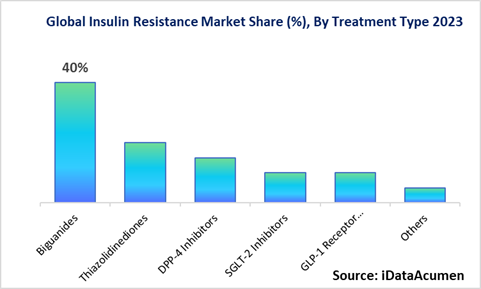Insulin Resistance Market is expected to reach US$ 32.8 Billion in 2030 with a growth rate of 4.9%.
The insulin resistance pharmaceuticals, devices, and supplements market caters to the rising patient pool suffering from insulin resistance conditions. Insulin resistance refers to a disorder where cells fail to respond normally to the insulin hormone, leading to abnormally high blood glucose levels. It is closely associated with obesity, physical inactivity, aging, and genetic factors. If left untreated, insulin resistance leads to the development of type 2 diabetes.
The market is driven by the globally rising prevalence of obesity and diabetes, sedentary lifestyles, unhealthy diets, growing geriatric population, and increasing research focused on elucidating the pathogenesis of insulin resistance to enable targeted therapy development. According to IDF estimates, the global diabetic population is expected to reach 643 million by 2030 and 783 million by 2045, up from 537 million in 2021. Most of these patients suffer from type 2 diabetes accompanied by insulin resistance.

Advances in pharmacologic treatment approaches, increasing adoption of associated devices like CGMs and insulin pumps, favorable reimbursement policies, and integration of digital health technologies such as mobile apps and telehealth services are powering the growth of the insulin resistance industry.
However, factors like high costs of branded drugs and devices, limited patient awareness, side effects of certain emerging insulin sensitizers, and stringent regulatory evaluations have constrained market expansion to some extent.
In terms of regional insights, North America is expected to dominate the insulin resistance market. Presence of key players, high diabetes prevalence, developed healthcare infrastructure, and favorable reimbursement drive the North American market growth.
Drivers:
- Rising global prevalence of obesity and diabetes, two key risk factors for insulin resistance. According to WHO, obesity has nearly tripled worldwide since 1975.
- Strong research focused on elucidating the molecular mechanisms underlying insulin resistance to enable targeted therapy development.
Trends:
- Increasing adoption of digital health technologies like mobile apps, telehealth services, wearables, and analytics software to optimize insulin resistance management.
- Growing demand among patients for non-invasive devices for glucose monitoring and insulin delivery.
Opportunity:
- Leveraging lifestyle interventions including dietary changes, exercise programs, and nutritional supplements to reduce insulin resistance.
Key Report Insights:
- North America accounted for the largest share of over 40.5% of the global market in 2023. Presence of key players like Eli Lilly, Abbott, Johnson & Johnson, favorable reimbursement, and high diabetes prevalence support the dominant position.
- Europe accounted for the second largest share of 29.7% in 2023, driven by rising obese and aging population in countries like Germany, France, Italy, and UK. Novo Nordisk, Sanofi, AstraZeneca, Roche have a strong presence.
- Prominent companies operating in the global insulin resistance market are Novo Nordisk, Sanofi, Eli Lilly, AstraZeneca, Abbott Laboratories, and Johnson & Johnson, among others. These players are focused on new product development and launches to gain share.
Insulin Resistance Market Segmentation –
- By Drug Class
- Biguanides
- Thiazolidinediones
- DPP-4 Inhibitors
- SGLT-2 Inhibitors
- GLP-1 Receptor Agonists
- Others
- By Route of Administration
- Oral
- Injectable
- Inhalable
- By Distribution Channel
- Hospital Pharmacies
- Retail Pharmacies
- Online Pharmacies
- Diabetes Clinics/Centers
- Regions
- North America
- U.S.
- Canada
- Europe
- Germany
- U.K.
- Spain
- France
- Italy
- Russia
- Rest of Europe
- Asia Pacific
- China
- India
- Japan
- Australia
- South Korea
- ASEAN
- Rest of Asia Pacific
- Latin America
- Brazil
- Argentina
- Mexico
- Rest of Latin America
- Middle East & Africa
- GCC Countries
- Israel
- South Africa
- North Africa
- Central Africa
- Rest of the Middle East
- North America
Definition:
“The insulin resistance market refers to the pharmaceutical drugs, medical devices, and associated components used for treating and managing insulin resistance conditions. Insulin resistance is a disorder in which cells fail to respond normally to the insulin hormone, leading to abnormally high blood sugar levels. The market caters to the growing patient pool through drugs that improve insulin sensitivity, devices for blood glucose monitoring, and increasing diagnosis. Key drivers are the rising prevalence of diabetes and obesity globally, growing geriatric population, sedentary lifestyles, and unbalanced diets. With advancing pharmaceutical research and integration of digital health technologies, the insulin resistance market aims to provide effective and personalized solutions for patients to prevent the progression to diabetes.”